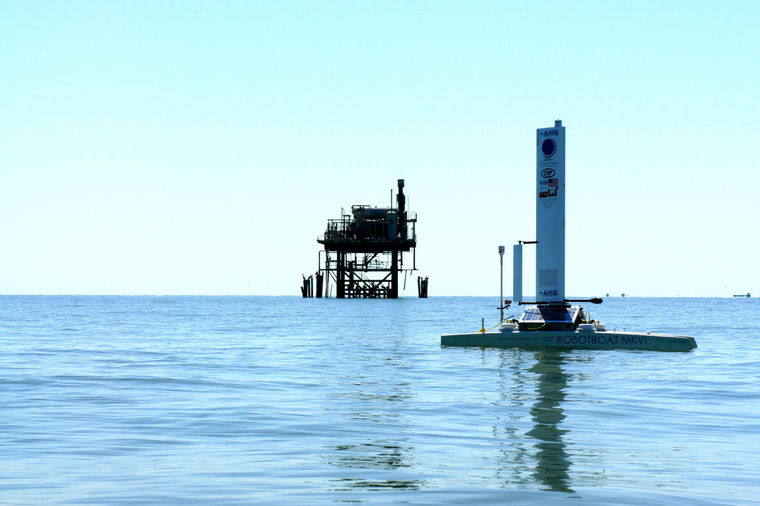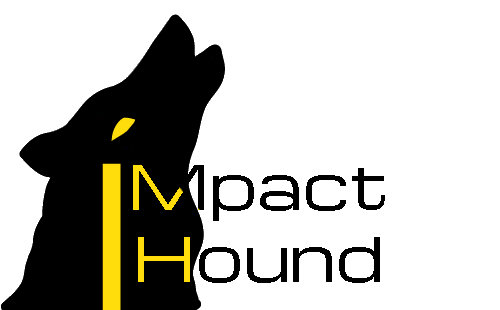26 Jun Energy: Autonomous Marine Systems
Introduction

Datamaran, a surface robot, by Autonomous Marine Systems. Credit: Autonomous Marine Systems
On June 18, 2015, I had the chance to talk with Eamon Carrig, the Chief Roboticist of the surface ocean drone startup Autonomous Marine Systems. The CEO, TJ Edwards, and Eamon Carrig were friends at Princeton University and later both worked at Planetary Systems Corp., a spacecraft mechanisms company in Maryland. Due to a combination of interest in robotics and sailing as well as concerns about climate change which is directly indicated by ocean health, they built their first sailing robot in 2006. The company was incorporated in 2009 and after several years of work, the founders quit their jobs to focus full-time on AMS in late 2012. The primary motivation came from the emergence of company Liquid Robotics which TJ and Eamon saw to be much too expensive for the mass deployment. They decided their technology could do better at far lower cost.
In 2012, they launched a successful Kickstarter campaign where they raised over eighty thousand dollars to build a prototype. They underwent a 6 week training session through the National Science Foundation’s Innovation Corps Program in Washington D.C. Later that year, they were accepted into the startup accelerator SURGE in Houston. Thanks to the mentorship and connections made through SURGE, they acquired funding to execute pilots and demonstrations.. When asked about the SURGE experience, Eamon had only positive things to say, “SURGE was awesome. Everyone there, from mentors to entrepreneurs, to the staff were top-notch.”
Technology
With the funding came the opportunity to fill out the team and further develop their technology. Their current product, available to select pilot customers, is called the Datamaran and it’s a simple, robust, fully autonomous, and fast, robotic catamaran that can be integrated with an assortment of sensors and instruments including cameras, LIDAR, and anemometers. The Datamaran is also undergoing extensive testing to work in fleets or swarms. The intelligent swarms will allow adaptive surveying where boats communicate with each other to best traverse an area for efficient, high resolution data collection.
These capabilities give the Datamaran great flexibility in a variety of missions. For instance, these devices can be used to replace buoys for oceanic science. Buoys are cheap but the boats to deploy and retrieve them along with periodic maintenance trips are not. In a swarm, they can be used to track oil spills or be used to search for deep sea petroleum deposits.
Autonomous surface vessels are relatively underdeveloped, largely in part to the technical challenges of operating at the surface, yet they can offer many advantages over underwater robots including access to RF communications (radio), access to satellite communications, and a greatly increased mission duration thanks to access to solar power. This combination of a long mission life and ability to communicate via multiple channels allows these little drones to operate autonomously for months to a year.
Business
Autonomous Marine Systems is a data service company rather than product oriented company. Instead of selling each boat directly to a client, they charge the client for the data that is collected. This way, AMS can operate and maintain the boats themselves, offering a more efficient service. Furthermore, this does not require customers to pay the upfront cost for each robotic drone ahead of time.
Eamon estimates that 30,000 boats are needed to cover the world. The Gulf of Mexico should take about 3000 boats thanks to its extensive communication tech. In the south Pacific, the boat numbers would be higher. These numbers are estimated based on the communication ranges between boats. Collecting these data and uploading them to the AMS servers also give the AMS the added advantage as a data hub of oceanographic information. This would be immensely valuable for research and defense organizations, especially in the ultimate quest of monitoring our planet’s fragile environmental state through ocean acidification sensors and other such sensors.
Conclusion
The team is currently composed of TJ, Eamon, Andew Punnoose – a former avionics integration lead for SpaceX, Josh Leighton and Chris Kennedy – two recent graduates of MIT and Embry-Riddle who placed 1st and 4th in the recent MaritimeRobotX challenge, and two business developers in the energy and defense space. Though the schedule is flexible, everyone understands that a successful startup requires tremendous effort. The core members of the team work vigorously at all hours of the day. Recently, Eamon was surprised to find himself on vacation for the first time in what seemed like a lifetime. “It was nice to get away from the day-to-day. It’s so hard, as a founder, to keep your focus on the business, rather than in the business. I had a chance to explore some new ideas without distraction.”
There was no need to ask how the company was able to make it so far. The company has faced dangers of failing including one period where both Eamon and TJ worked on this for free. They’re still in startup mode though it’s not a safe bet yet. Thankfully, they have supportive families and loving wives as well as their core belief that their lives are for this purpose. Eamon eloquently volunteered how they’re able to plug on despite the many challenges facing them, “We’re too stupid to know when to quit.” When asked how he feels about working on this if it takes ten years to get to a global coverage (which is the aim), he continued with equal optimism, “The sea suffers no fools. I can’t think of a more worthy challenge than helping to understand the oceans.”
Find out more information on Autonomous Marine Systems at www.automarinesys.com/ . You can also follow them various channels including
Crunchbase
https://www.crunchbase.com/organization/autonomous-marine-systems
LinkedIn
https://www.linkedin.com/company/autonomous-marine-systems
Consider following Shen Ge on @shenge86 for more up-to-date blog posts.



